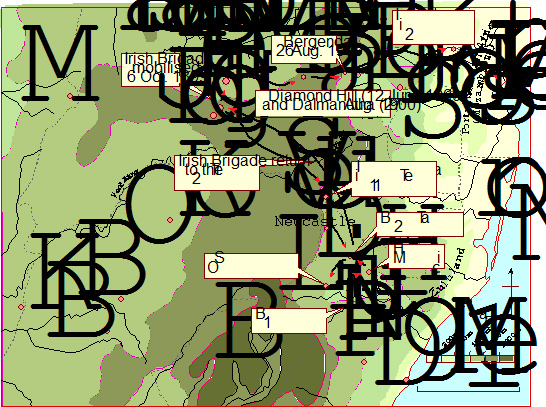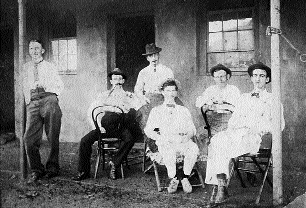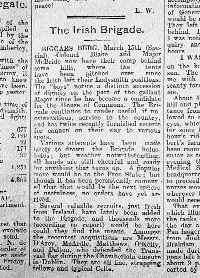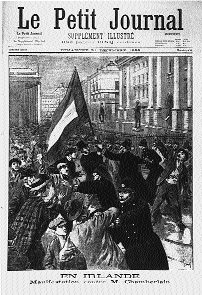MacBride’s Brigade in the Anglo-Boer War
Published in 18th–19th - Century History, 20th-century / Contemporary History, Features, Issue 1 (Spring 2000), Volume 8
(Matthew Stout)
At the top of Dublin’s Grafton Street, at the corner of Stephen’s Green, stands a handsome triumphal arch—still referred to by some locals as ‘traitors’ gate’—which commemorates the ‘officers, non-commissioned officers and men’ of the Royal Dublin Fusiliers who fell in the second Anglo-Boer war (1899-1902). One will search Ireland in vain to find a counterpart: a memorial to those Irish soldiers who died fighting in the two Irish commandos in the Boer army. It is a strange omission since at the time ‘pro-Boer fever’ engulfed nationalist Ireland. Pro-Boer demonstrations were held, pro-Boer rioting occurred, the flag of the Transvaal Republic—the vierkleur—was to be seen in Dublin, where for a period there even existed a no-go area at night for forces of the crown.
South Africa had not witnessed mass Irish immigration, nonetheless in the mid-1890s, Dublin Castle officials began to notice that numbers of advanced Irish nationalists were making for the unsettled South African, or Transvaal, Republic. These included Celtic Literary Society members John MacBride and Arthur Griffith. By 1896 there were about 1,000 Irish living in the mining settlement of Johannesburg as well as others in Pretoria and in more far-flung dorps, such as Middelburg where Griffith edited the precursor to the United Irishman. Unlike the English uitlanders, these Irish settlers supported Kruger’s regime and in turn when a 1798 celebration was held in Johannesburg—an event which eclipsed that in Dublin—Afrikaners were prominent at the march and banquet.
Organisation of the Irish commando
For reasons unclear, Griffith returned to Dublin in October 1898, but there were more new arrivals in the Transvaal from Ireland by the day. When it became clear that the South African Republic would go to war with Britain, clandestine Irish meetings were held in John Mitchell’s clothes cleaning shop in Johannesburg and by September 1899, with the help of a shadowy South African-Irishman named Solomon Gillingham, a proposal for a 700-strong Irish Transvaal Brigade was accepted by the Boer government. This was one of a handful of foreign commandos raised to support the Transvaal and its sister republic, the Orange Free State. ‘Foxy Jack’ MacBride from Mayo declined the command so instead the Irish lads turned to a colourful American called John Blake. Tall and broad-shouldered, he looked like Buffalo Bill and had spent many years in the 6th US cavalry in the wild west fighting the Apache and the Navaho.
In all, some 300 men joined the Irish brigade, including a Catholic chaplain, some Gaelic speakers and about forty Protestants. There were two sets of fathers and sons. Only a few men, however, had fighting experience. Little if any thought was given to the prospect of joining a Calvinist army and, as in Ireland, the plight of the black population was not an issue; hatred of the English and the prospect of the rebirth of the wild geese was the simple rationale. Despite the attraction of the new brigade, some Irish, in the words of the Irish pro-Boer campaigner Michael Davitt, ‘have the good sense to remain with their Boer officers’. These Irishmen were to be found in at least six other Boer commandos.
On 6 October 1899 the Irish Transvaal Brigade mobilised and boarded trains for the Transvaal-Natal frontier. Issued at first with single-shot Martini rifles, soon most of the Irish commando had acquired captured Lee Enfield and Lee Metford rifles. They were also issued with horses and had to spend several painful days on the highveld learning to ride. On Wednesday 11 October, in a severe thunderstorm, the brigade crossed into British territory. Ahead lay the colony of Natal with its Irish governor, its Irish prime minister and several Irish regiments of the British army.
The siege of Ladysmith
The Irish commando was in the van of the Boer army when the town of Newcastle was occupied and looted. The dividing line between commandeering and looting is fine and the Irish corps were sometimes accused of crossing it. Perhaps because of this they were initially assigned to accompany and guard one of the great French Creusot fortress guns, or ‘Long Toms’, of Commandant Trichardt’s Transvaal State Artillery.
At the battle of Talana Hill on 20 October 1899 the Irish commando played a small part and it was here they first came up against Irish regiments. Throughout the war great animosity existed between the Irish who opposed each other from either side. Soon the Irish commando was ensconced on Pepworth Hill overlooking the besieged garrison town of Ladysmith, where there were members of the Irish Fusiliers, the Irish Regiment, the 5th Royal Irish Lancers and some of the Dublin Fusiliers, all of whom were very eager to get their hands on the ‘flying Fenians’ of MacBride’s Brigade.

John MacBride (leaning against the post) and Arthur Griffith (standing) in the Transvaal Republic, c. early 1898. (Brian Mooney)
At the battle of Modderspruit the Irish commando lost several men, including the eighteen-year-old Tommy Oates from Killarney, whose father was also in the unit. ‘To get my guns, the English will have to kill my Irish troops’, proclaimed Trichardt. And he was correct. The Irish commando protected the guns on Pepworth Hill, but also indulged in some fairly foolhardy horse-rustling activities on the British perimeter. Some of the brigade’s members also fought opposite the Dublin Fusiliers at the battle of Colenso on 15 December. Here MacBride had his horse shot from under him, but the major survived. The Irish were among the first to cross the Tugela River and capture Captain Long’s field-artillery pieces.
That Christmas Day 1899, under the flag sent out by Maud Gonne and the Dublin-based Irish Transvaal Committee, the Irish held a horse race behind Pepworth Hill and then a banquet was laid on for Commandant General Joubert and many Boer officers and their wives. The event was, however, ‘painfully dry’.
Irish commando members fought in the battles of Spion Kop and Vaal Krantz, as well as in the final battle of Tugela Heights when Buller’s army, with its 5th (Irish) Brigade, broke through and relieved Antrim-born General Sir George White in Ladysmith. The Irish commando fought well and indeed for a while in the driving rain held the road to the north against Lord Dundonald’s cavalry, allowing the Boers to bring up their oxen to drag out the artillery. Soon the Irish lads were safe, but bored, in the mountains of the nearby Biggarsberg.
Rivalry and reinforcements
There had also been a certain amount of dissension in Irish ranks. This was not helped by the Boer army’s democratic structure and cavalier attitude to military discipline. As the months progressed, disunity spread in Irish ranks. Colonel Blake became more distant from the unit and Major MacBride, his number two, increasingly became the de facto leader. But MacBride had enemies and when news reached camp that a second and rival Irish Transvaal Brigade was being formed in Johannesburg by a newly arrived Irish-Australian called Arthur Lynch, some members of the original Irish commando went over to the new unit. This was at most 150-strong and soon only about fifty in number. It was denounced by one member of MacBride’s outfit as ‘fifty or sixty soreheads, greasers, half-breeds and dagos…a gang of hobos’. It is as well they did not fight alongside each other.
The second Irish Transvaal Brigade was posted to the Helpmekaar Pass on the Biggarsberg where they fought well during the Boer retreat up to Laing’s Nek on the Natal border. MacBride and Blake took their unit to Johannesburg, where they were joined by fifty-eight members of an Irish-American ‘ambulance corps’ from Chicago and New York. Though there were seven American doctors among them, the rest of the men under Captain O’Connor flagrantly used their Red Cross accreditation to get out of America to Africa to fight for the Boers. The new combined Irish force now moved to the front line in the Orange Free State. Here they faced Lord Roberts’ army of 45,000 men.
![The Irish Transvaal Brigade in the field, complete with flag sent from Ireland by Maud Gonne and the Irish Transvaal Committee. ‘Mind the flag', were some of the last words of John MacBride before his execution in 1916. (Priem, De Oorlog in Zuid Afrika [1900])](/wp-content/uploads/2013/02/MacBrides-Brigade-in-the-Anglo-Boer-War-3.jpg)
The Irish Transvaal Brigade in the field, complete with flag sent from Ireland by Maud Gonne and the Irish Transvaal Committee. ‘Mind the flag’, were some of the last words of John MacBride before his execution in 1916. (Priem, De Oorlog in Zuid Afrika [1900])

Report in the pro-Boer Standard and Digger’s News, 19 March 1899.
A cat-and-mouse game with the British cavalry began—with the Irish as the mouse. Some of MacBride’s men were formed into a ‘dynamite squad’ or ‘wreckers’ corps’, blowing up railway bridges and facilities as the Boer army retreated. This, done with their daredevil tactics, made the Irish very valuable to the Boers. But the British advance was not halted and on 23 May 1900 the Irish brigade crossed the Vaal River and entered the Transvaal.
Retreat and ‘bitter end’
Lynch’s commando survived only a couple of months and by the time the British army was south of Johannesburg, it had disintegrated and Lynch was thinking of clearing out of South Africa. Johannesburg had been the home of many of the Irish gold miners in the two commandos and some were reluctant to leave, preferring to disappear into the side streets of the Fordsburg suburb.
Others, however, were determined not to vacate the town without a struggle and one of the fiercest fire fights was in Orange Grove as the British army pressed the retreating Irish from street to street. Just after this, Lynch and MacBride came upon each other—both covered in dust, exhausted and battle weary. They exchanged greetings and parted forever.
Soon Colonel Blake had to vacate his comfortable surroundings in Pretoria’s Grand Hotel. The retreat across the eastern Transvaal highveld had begun. Before long Blake had left the Irish commando altogether to fight elsewhere and for the last two months of its existence, MacBride was in sole command.
Back in Ireland, of course, it had always been ‘MacBride’s Brigade’ in any case.
A campaign there against recruitment to the British army met with some success. Then Maud Gonne had involved herself in intrigues with the Boer representative in Europe, unaware that he was already in cahoots with the IRB. The visit to Ireland in April 1900 of Queen Victoria had for a while dampened the Irish pro-Boer cause, but by mid-summer the Boer colours were to be seen all over Dublin. Also by then reports of Michael Davitt’s much-publicised visit to the Boer front lines had appeared in the Freeman’s Journal.
Back in the eastern Transvaal the Irish brigaders were suffering. Food was short, as were horses and clothes. Tempers frayed. There were those with horses under Major MacBride and Captain McCallum and there were the ‘foot sloggers’ under Captain O’Connor and Lieutenant Ryan. MacBride was in overall command. The Irish fought at the battles of Diamond Hill on 12 June and Dalmanutha on 27 August, but most of the time they harassed the British advance, most notably when they held the town of Belfast for several hours under heavy fire. But the game was up and by mid-September 1900 MacBride could hardly control his men as they moved over the great escarpment and down into the hot and humid lowveld. But still they fought on, now under the overall command of General Viljoen. Finally on Sunday, 23 September 1900, they reached Komatipoort and the Mozambique border. With testimonials from State Secretary Reitz and General Botha in his pocket, Major MacBride said farewell to his horse, Fenian Boy, and, with what was left of his brigade, boarded a train which clattered across the great iron bridge over the Komati River and into Portuguese territory.
![MacBride's Brigade at their camp outside Ladysmith. (Davitt, The Boer Fight for Freedom [1902])](/wp-content/uploads/2013/02/MacBrides-Brigade-in-the-Anglo-Boer-War-5.jpg)
MacBride’s Brigade at their camp outside Ladysmith. (Davitt, The Boer Fight for Freedom [1902])
Echoes
When peace came in May 1902, most of the Irish had little choice but to make their way to Europe or America, where MacBride’s men had preceded them. In 1901 Lynch had got himself elected to an Irish seat in parliament, something MacBride had not achieved; but returning from Paris to England, he had been arrested, tried and convicted of high treason. Unlike MacBride and his men, Lynch had taken out Transvaal citizenship only after war had broken out, thus laying himself open to this treason charge. But lucky as ever, and much to the regret of many of MacBride’s men, Lynch escaped the hangman’s noose and was eventually pardoned.
The Irish had fought well in the war. Accusations that they were more fond of the bottle than the battle are false: they were fond of both. We know the names of ninety-one casualties in the Irish commandos, thirty-one of whom were killed, twenty-three wounded and twenty-seven made prisoners-of-war. Compared with the 4,452 casualties in the war from Irish regiments this is insignificant, but it was the activities of ‘MacBride’s Brigade’ which had caused excitement in Ireland.

Back home nationalist Ireland was engulfed by pro-Boer fever-an anti-war demonstration (complete with Boer flag) outside Trinity College, Dublin. (Le Petit Journal, 31 December 1899)
The publication of Blake’s war memoir, Davitt’s The Boer Fight for Freedom, and later of a series of thirteen articles by MacBride in the Freeman’s Journal kept this memory alive. So, too, did the 1903 Paris wedding of MacBride and Maud Gonne, who were married under the brigade’s flag by the brigade’s chaplain. Reports of a son born in the Transvaal to MacBride would emerge only eighty years later.
In Dublin, 1899 was a dry run for 1916. When the rising finally came, though, MacBride stumbled on it by accident—but was soon once again number two in a fighting unit. Elsewhere in the city other former Irish Transvaal brigaders also fought the English again. When the British army was mopping up after the insurrection, they found rifles with Boer carvings on their butts. Shortly before Major MacBride was executed by firing squad in Kilmainham, he is reported to have said: ‘I have looked down the muzzles of too many guns in the South African war to fear death, and now please carry out your sentence’.
Donal McCracken is Dean of Arts and Professor of History at the University of Durban-Westville.
Further reading:
D.P. McCracken, MacBride’s Brigade (Dublin 1999).
D.P. McCracken, The Irish pro-Boers, 1877-1902 (Johannesburg 1989).
S. Monick, Shamrock and Springbok (Johannesburg 1989).
















